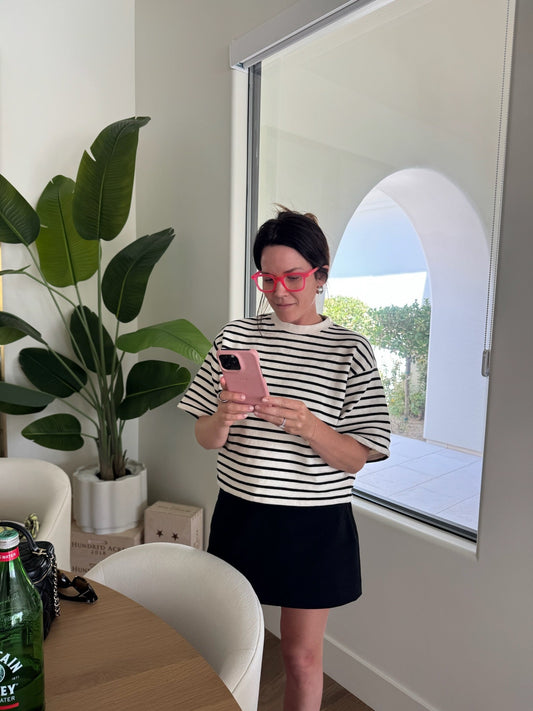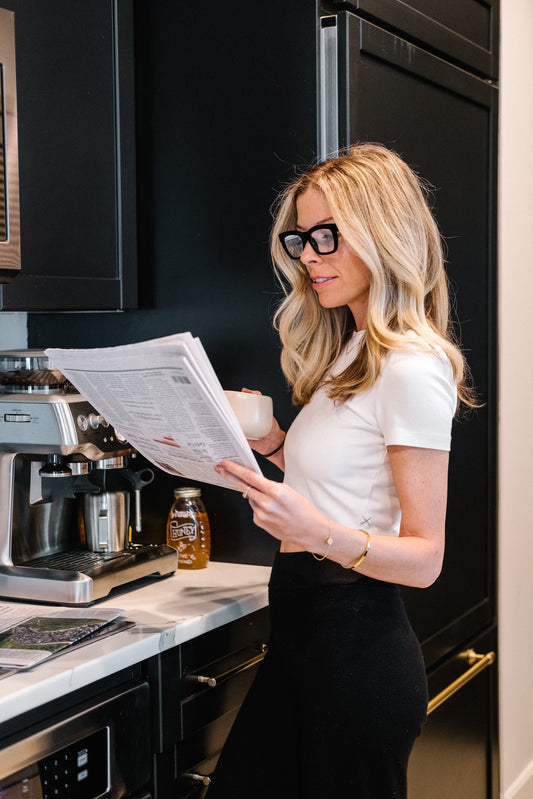Evenings are for winding down. A blanket, your favorite show, and a quiet couch can turn a long day into something soft and calm. You can keep that ritual and still protect your sleep with a few smart tweaks and a cozy routine.
This guide shows how screen time and sleep can work together. You will learn what light does to your body at night, which simple settings help, and where blue light glasses fit in.
The goal is comfort, not perfection, so you can stream and still wake up rested.
How does screen time impact your sleep?
Light is a powerful signal for your brain. Blue wavelengths in particular tell your internal clock that it is daytime, which can delay melatonin and make it harder to fall asleep.
When that delay stacks up over the week, your whole schedule can drift later.
It is not only phones that matter. Bright room lighting before bed also suppresses melatonin and nudges your timing later, even if you feel relaxed on the sofa.
Keeping the evening a little dimmer supports the chemistry that helps you get sleepy on time.
Timing plays a role too. Watching right up to lights-out keeps your brain alert longer than you expect, so leave a brief buffer between the finale and your pillow to let your system settle. That small gap can make a noticeable difference in how quickly you drift off.
What settings make nighttime screens less harsh?
Warmer and dimmer is your friend after sunset. Most phones and tablets have a night mode that shifts the display toward amber tones on a schedule, which feels easier on the eyes in low light. TVs and laptops can be dimmed and warmed as well, especially in rooms with a single warm lamp rather than overhead glare.
On iPhone and iPad, Night Shift uses your clock and location to move colors warmer after sunset and back again in the morning.
On Android, Night Light reduces blue output and lets you set intensity and timing to match your evening rhythm. These are easy wins you set once and then forget.
Distance also helps. Sitting a bit farther from the TV and holding a phone at a comfortable arm’s length reduces light intensity and visual effort.
Add a small, warm lamp beside or behind the screen to soften contrast, and the whole scene feels calmer on your eyes.

Do blue light glasses help you sleep better?
Blue light glasses can support a gentler evening, but they work best as part of a broader setup. High-quality lenses that actually block the stimulating wavelengths may reduce the “daytime” signal your brain gets while you stream at night. Paired with warmer screens and softer room light, they can make your wind-down more sleep-friendly. (Harvard Health)
Habits and settings still matter. Think of the glasses as a cozy add-on that stacks with other small improvements rather than just a stand-alone fix. (PubMed)
For something that looks good and feels good, reach for Eyejets Blue Light Blocking Readers. They bring comfortable fit and a sleep-smart vibe to your nightly watch, so your routine stays stylish and simple while you unwind.
How to build a cozy Netflix-at-night routine
Set a wind-down window
Give yourself 60 to 90 minutes before bed where everything slows down. Pick a latest “lights out” time so your evening ends soft, not rushed. That small boundary teaches your body when to get sleepy.
Set the scene
Turn on a warm lamp, lower the display, and switch devices to night mode. Keep water or herbal tea nearby and get comfortable with a throw and a supportive pillow. The aim is gentle light, calm sound, and an easy pace.
Add Eyejets to the mix
Slip on your Eyejets Blue Light Blocking Readers when you press play. Treat that moment as your nightly cue that work is done and it is time to unwind. Small, repeatable cues make routines stick.
Mind your distance and posture
Sit a bit farther from the TV and keep your phone at a relaxed arm’s length. Rest your shoulders, support your lower back, and keep the screen near eye level. When your body feels supported, your brain can downshift.
Pause with purpose
Use commercials for a quick reset. Look at something across the room for a few breaths and blink slowly to re-hydrate your eyes. These tiny breaks protect comfort without breaking the mood.
Close softly
End the final episode 20 to 30 minutes before bed and dim the lamp another notch. Turn on Focus or Do Not Disturb, put screens away, and finish with skincare, a light stretch, or a few pages of a book. That gentle landing tells your system sleep is next.
A one-week challenge for better sleep without giving up streaming
Day 1
Turn on night mode across your devices and lower evening brightness. Pick a target bedtime and set a friendly reminder 30 minutes ahead so the night has a soft landing.
Day 2
Switch off overheads and keep a warm lamp on for the last hour. Wear your Eyejets Blue Light Blocking Readers for any after-sunset screen time and notice how the scene feels.
Day 3
Build two short resets into one episode. Look across the room for a few breaths, roll your shoulders, and blink slowly to ease tension. Keep water or herbal tea nearby and skip late caffeine.
Day 4
Stop the final episode 30 minutes before bed and give yourself a quiet buffer. Use that window for skincare, journaling, or light reading under a warm lamp so your mind coasts into sleep.
Day 5
Enable Focus or Do Not Disturb for the final hour. Place your phone out of arm’s reach after the show so reflex scrolling does not pull you back in.
Day 6
Keep bedtime and wake time consistent. Dim the evening environment and get a little morning light the next day to keep your rhythm steady.
Day 7
Check in with yourself after breakfast. If you fell asleep faster or woke up clearer, keep the habits that helped most and make them your new normal.
Sleep-friendly screen time
You can enjoy your shows and still sleep well when your evening setup supports your biology. Warm the display, dim the room, take brief eye resets, and bring in blue light blocking for a softer night. When comfort and calm are the goal, Eyejets Blue Light Blocking Readers fit right in with blankets and tea.



